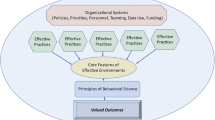Abstract
The present article examines the nature of and relations among the domains of behavior analysis. It first proposes a set of annotated, descriptive criteria to aid in distinguishing the experimental analysis of behavior, applied behavior analysis, and service delivery. It then argues that the experimental analysis of behavior lies at one end of a continuum of behavior-analytic activity, with applied behavior analysis in the middle, service delivery at the other end, and the theoretical-philosophical-conceptual position known as “radical behaviorism” informing the three domains on the continuum. Finally, it argues that clarifying the distinctions among the domains of behavior analysis will help the behavior-analytic community to focus its efforts in training programs and overall support of behavior analysis.
Similar content being viewed by others
References
Azrin, N. H., & Foxx, R. M. (1971). A rapid method of toilet training the institutionalized retarded. Journal of Applied Behavior Analysis, 4, 89–99.
Azrin, N. H., & Nunn, R. G. (1973). Habit-reversal for habits and tics. Behavior Research and Therapy, 11, 619–628.
Baer, D. (1978). On the relation between basic and applied research. In A. C. Catania & T. A. Brigham (Eds.), Handbook of applied behavior analysis (pp. 11–16). New York: Ir-vington.
Baer, D. (1981). A flight of behavior analysis. The Behavior Analyst, 4, 85–91.
Baer, D., Wolf, M., & Risley, T. (1968). Some current dimensions of applied behavior analysis. Journal of Applied Behavior Analysis, 1, 91–97.
Baer, D., Wolf, M., & Risley, T. (1987). Some still-current dimensions of applied behavior analysis. Journal of Applied Behavior Analysis, 20, 313–327.
Barrish, H. H., Saunders, M., & Wolf, M. M. (1969). Good behavior game: Effects of individual contingencies for group consequences on disruptive behavior in a classroom. Journal of Applied Behavior Analysis, 2, 119–124.
Birnbrauer, J. S. (1979). Applied behavior analysis, service, and the acquisition of knowledge. The Behavior Analyst, 2, 15–21.
Bush, V. (1946). Endless horizons. Washington, DC: Public Affairs Press.
Catania, A. C., & Harnad, S. (Eds.). (1988). The selection of behavior: The operant behaviorism of B. F. Skinner: Comments and controversies. Cambridge, UK: Cambridge University Press.
Deitz, S. M. (1978). Current status of applied behavior analysis: Science versus technology. American Psychologist, 33, 805–814.
Deitz, S. M. (1983). Two correct definitions of “applied.” The Behavior Analyst, 6, 105–106.
Diamond, R., & Adam, B. (1993). Recognizing faculty work: Reward systems for the year 2000. San Francisco: Jossey-Bass.
Foxx, R. M., & Bechtel, D. R. (1983). Overcorrection: A review and analysis. In S. Axelrod & J. Apsche (Eds.), The effects of punishment on human behavior (pp. 133–220). New York: Academic Press.
Foxx, R. M., & Shapiro, S. T. (1978). The timeout ribbon: A non-exclusionary timeout procedure. Journal of Applied Behavior Analysis, 11, 125–143.
Hawkins, R. P., & Anderson, C. M. (2002). On the distinction between science and practice: A reply to Thyer and Adkins. The Behavior Analyst, 25, 115–119.
Hayes, S. S., Rincover, A., & Solnick, J. V. (1980). The technical drift of applied behavior analysis. Journal of Applied Behavior Analysis, 13, 275–285.
Johnston, J. M. (1979). On the relation between generalization and generality. The Behavior Analyst, 2, 1–6.
Johnston, J. M. (1996). Distinguishing between applied research and practice. The Behavior Analyst, 19, 35–47.
Krapfl, J. E., & Vargas, E. A. (Eds.). (1977). Behaviorism and ethics. Kalamazoo, MI: Behaviordelia.
Mace, F. C. (1994). Basic research needed for stimulating the development of behavioral technologies. Journal of the Experimental Analysis of Behavior, 61, 529–550.
Michael, J. (1980). Flight from behavior analysis: Presidential address ABA 1980. The Behavior Analyst, 3, 1–22.
Moore, J. (1999). On the principles of behaviorism. In B. A. Thyer (Ed.), The philosophical foundations of behaviorism (pp. 41–68). Dordrecht, The Netherlands: Kluwer.
Moore, J., & Shook, G. (2001). Certification, accreditation, and quality control in behavior analysis. The Behavior Analyst, 24, 45–55.
Pennypacker, H. S., & Hench, L. L. (1997). Making behavioral technology transferable. The Behavior Analyst, 20, 97–108.
Sidman, M. (1960). Tactics of scientific research. New York: Basic Books.
Skinner, B. F. (1969). Contingencies of reinforcement. New York: Appleton-Century-Crofts.
Stokes, D. E. (1997). Pasteur’s quadrant. Washington, DC: Brookings Institution Press.
Wolf, M. M. (1978). Social validity: The case for subjective measurement or how applied behavior analysis is finding its heart. Journal of Applied Behavior Analysis, 11, 203–214.
Wolf, M. M., Phillips, E. L., & Fixsen, D. (1972). The teaching family: A new model for the treatment of deviant child behavior in the community. In S. W. Bijou & E. Ribes-Inesta (Eds.), Behavior modification: Issues and extensions (pp. 51–62). New York: Academic Press.
Author information
Authors and Affiliations
Corresponding authors
Rights and permissions
About this article
Cite this article
Moore, J., Cooper, J.O. Some proposed relations among the domains of behavior analysis. BEHAV ANALYST 26, 69–84 (2003). https://doi.org/10.1007/BF03392068
Published:
Issue Date:
DOI: https://doi.org/10.1007/BF03392068




